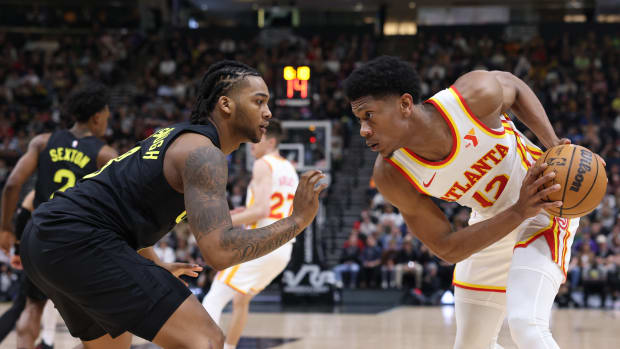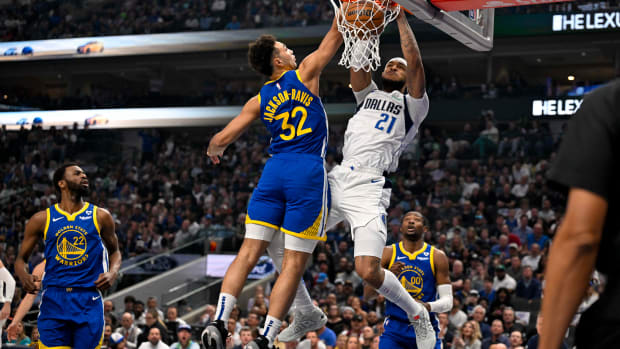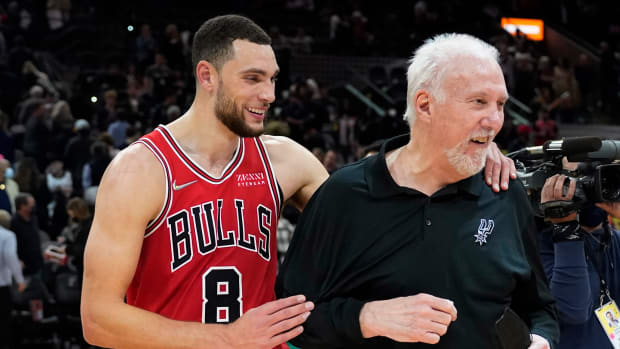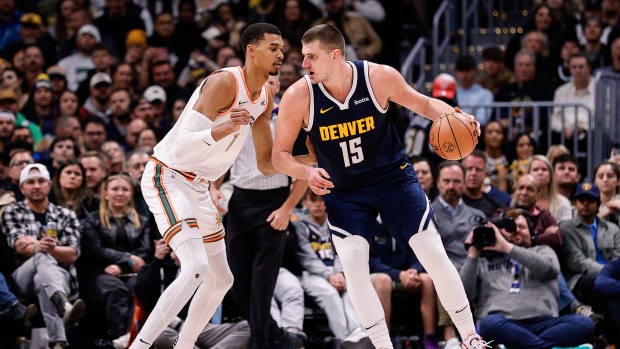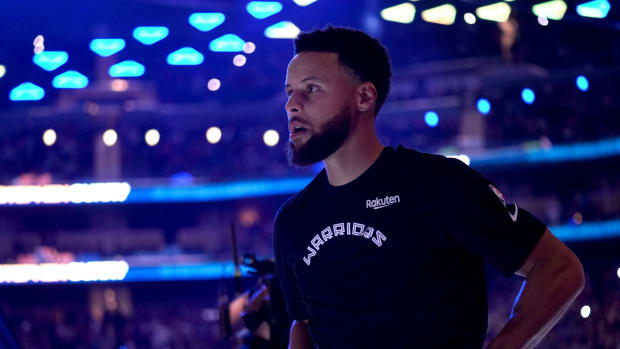Analyzing the ‘new Derrick Rose’ in healthiest season since ’11
Get all of Jeremy Layton’s columns as soon as they’re published. Download the new Sports Illustrated app (iOS or Android) and personalize your experience by following your favorite teams and SI writers.
As the Chicago Bulls sit 2.5 games out of playoff position with just 10 games left to play, it’s nearly safe to call the first season of the Fred Hoiberg era a disaster. Almost the same roster that finished third in the East last year could completely flop in 2016, as injuries, locker room dysfunction and regression from key players may doom the Bulls to the draft lottery. But as brutal as this season has been in Chicago, there’s at least one glimmer of hope: The oft-injured Derrick Rose is close to finishing his most complete season since 2011.
Even with 10 contests remaining, Rose has already played his highest number of games since he was crowned league MVP five years ago (though this includes the lockout-shortened 2011–12 campaign), and if he survives the next two weeks, he will complete a regular season without a major knee injury for the first time in four years.
NBA Week in Review: Warriors' chase for 73, Blake's return and more
Rose’s season hasn’t been without some frustrating ailments and public criticisms—he missed a February game against the Hornets due to “general soreness,” for example. But since the All-Star break, Rose has quietly played very well, averaging 19.9 points per game on 51.4% shooting over that span. For the first time in years, he has managed to stay healthy long enough to shake off the rust gathered over the past few seasons, and is playing his best basketball in recent memory.
Which is enough to bring up an age-old question: is the “old Derrick Rose” finally back? And if he’s not, what kind of player can we expect going forward?
Looking at the statistics, it’s clear that Rose has made significant progress throughout this season. In November, while he was seeing double after having orbital bone surgery, Rose was one of the least efficient players in the NBA, averaging a mere 13.3 points per game while attempting more than 15 shots a game. But his numbers have seen a marked improvement in the months following. Here’s a chart of some shooting statistics in each month of the 2015–16 season:
month | ppg | fg% | fga | 3P% |
November | 13.3 | .353 | 15.3 | .231 |
December | 15.3 | .414 | 15.4 | .286 |
January | 17.6 | .471 | 15.7 | .292 |
February | 21.9 | .439 | 19.4 | .316 |
March | 18.4 | .497 | 15.8 | .419 |
Considering February an outlier, a month which saw him taking more shots in the injured Jimmy Butler’s absence, Rose’s scoring and field goal percentage have made a steady jump each month, all while he has attempted nearly the same number of shots per game. March 2016 has been Rose’s best shooting month since April 2011 (the tail end of his MVP season), when he averaged 25.4 points per game on 52% shooting. He’s even found his touch from distance of late—his 41.9 three-point percentage in March is his best mark since December 2010.
• Bulls hold team meeting after losing their third straight game
Rose is still not putting up MVP-like numbers, and other statistics don’t look as promising, especially when compared to the rest of his career. In 2015–16, he’s averaging a career low in free throw attempts, only getting to the line 2.9 times a game. Prior to this year, he never averaged fewer than three attempts, even during his injury-shortened seasons. And it’s not because he isn’t attacking the basket—he’s actually set career highs in percentage of points in the paint and career lows in three-point attempts this year. Here is a chart of those stats from 2010–11 onward:
year | FTa | 3pa | points in paint |
2010-11 | 6.9 | 4.8 | 39.8% |
2011-12 | 6.1 | 4.4 | 42.3% |
2013-14 | 3.2 | 4.7 | 42.8% |
2014-15 | 3.7 | 5.3 | 42.3% |
2015-16 | 2.9 | 2.3 | 48.4% |
These numbers, in the context of this NBA season, make about as much sense as the fact that DeAndre Jordan’s field goal percentage is 26.4% higher than his free throw percentage. But if you compare Rose’s game before his injuries to his game now, you’ll notice a big difference in his shot selection that might explain it. Five years ago, before he had two surgically repaired legs, Rose consistently attacked the rim with reckless abandon, taking on two or three defenders along the way. Watch at 1:50 of the following video, as he steamrolls then-Pacer Brandon Rush:
Rose was then what Russell Westbrook is now: a freight-train guard exploding to the rim on every opportunity, taking out anyone in his path and drawing fouls. But after three surgeries in three years, that’s a recklessness he can’t afford to play with anymore. Now, instead of challenging defenders with power, he’s doing so with his elite quickness, an element of his game that survived the surgeries. Watch at 0:26 of this video, as he beats Jose Calderon along the baseline and launches himself away from the rim for an acrobatic reverse layup:
[youtube:https://youtu.be/eGevwb-29YU]
In 2011, Rose might have dunked that ball, but instead of challenging the defender head on, he avoids contact and contorts his body to lay it in. Much has been written about Rose’s “cautious” attitude to the season—he’s still missed 12 games this year, all for various strains and ailments—and that caution seems to have translated onto the court. Incredibly, he recorded his first dunk of the season during that same Knicks game—71 games into the season. This after spending the first four years of his career as the most prolific dunking point guard in the league.
• Stock watch: Hield among those helping their NBA draft cases in Big Dance
But not only is Rose’s new approach cautious, it’s also smart. The 27-year-old has a year left on his contract, and the Bulls’ front office will have an interesting decision to make in the summer of 2017. That decision will likely rest on his ability to stay on the court over the next year and change, and one more major injury may mean the end of his career, at least in Chicago.
After finally managing to get significant playing time under his belt, however, Rose seems to have found a new, successful formula as a basketball player. He’s tempered his approach and adapted his game to reduce the risk of injury, and it’s working. We may never see the “old Derrick Rose” again, and that’s something that Bulls fans must wrap their heads around. But the “new Derrick Rose” is proving to be a highly effective player, and if he continues to stay healthy, there’s no reason to think his upward trend won’t continue.






























